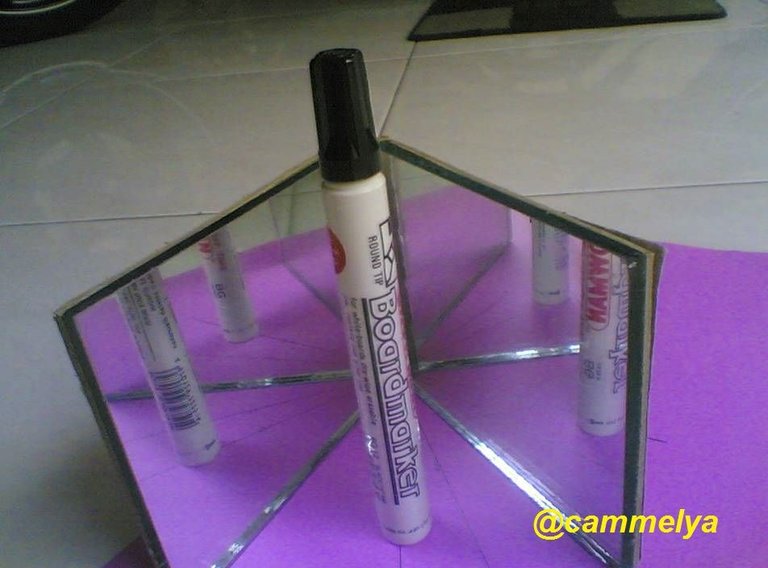Hello all steemian friends. This time I will provide an information on how to facilitate the learning of science about the understanding of mirror by creating the media of learning about plane mirror.
The purpose of making this media is to investigate the properties of light and its relation to various forms of mirrors and lenses. That is by describing the process of forming the shadow on combinating 2 flat mirrors (plane mirror).

Theory
A plane mirror is a mirror with a flat (planar) reflective surface. For light rays striking a plane mirror, the angle of reflection equals the angle of incidence. The angle of incidence is the angle between the incident ray and the surface normal (an imaginary line perpendicular to the surface). Therefore, the angle of reflection is the angle between the reflected ray and the normal and a collimated beam of light does not spread out after reflection from a plane mirror, except for diffraction effects. Source
Shadow Properties on A Plane Mirrors
The mirror used to decorate includes a flat mirror, a mirror whose surface reflects a flat plane. What is the principle of shadow formation in a flat mirror? How are the shadow properties that occur on a flat mirror? The process of forming a shadow on a flat mirror uses the law of light reflection. To facilitate the formation of its shadow, rays are taken from both ends of the object.
The shadows that occur in flat mirrors have properties, that is a. virtual or pseudo because the shadow can not be captured screen; b. distance of object equal to distance of shadow; c. the height of the object is equal to the height of the shadow; d. the position of the shadow is opposite to the position of the object.
Learning Objectives to students
Knowing the shadow formation process at combining 2 flat mirrors. Determining the number of shadows formed from the composite of 2 flat mirrors and can find common equations for determining the number of shadows formed from the incorporation of 2 flat mirrors.
Tools and materials used for composite 2 flat mirrors :
- Mirror
- Glue
- Cardboard
- Scissors
- Knife
- Protractor (Measuring instrument)
- Ruler
- Pencil
- Markers
How to Create Media composite 2 plane mirror
- Measure the size of the mirror by using a ruler 10 x 10 cm
- Then cut the mirror with the size 10 x 10 cm as much as 2 pieces

- Measure the size of a cardboard using a 12 x 25 cm ruler the cut it with scissor
- Stick the back of both mirrors with a thick cardboard to composite

Composite the two flat mirrors

Certain angle shapes to define shadows

Objects between angles 900

Objects between angles 600

After Finished Created the Media
What are students do in the learning process
- Form a specific angle of two flat mirrors
- Place the object between the two flat mirrors
- Suppose the angle is 180, 90, 60, 45 and 30 degree and read (count) how many shadows are formed
- Write the value you got in the following table :

Conclusion
The process of learning by using this medium can improve students' understanding, because students are actively involved in it.
By following the instructions of the Student Worksheet, students can learn more independently and find themselves the expected concept.
Especially on this topic students find themselves equations to determine the number of shadows after a few experiments.